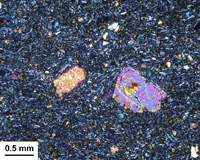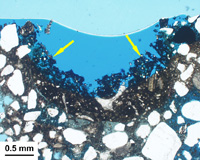
An aggregate supplier was hesitant to use a local rock source fearing that the volcanic rocks would be susceptible to alkali-silica reaction. Petrography revealed crystals of olivine (brightly colored grains) in a matrix of fine-grained plagioclase feldspar. The rock is identified as a basalt and considered safe to use in portland cement concrete without the need for special admixtures.

Pockmarks along a public water supply concrete pipe liner resulted in significant friction losses and inefficient water transport. Petrographic examination shows that the coarse aggregate chosen for the concrete design has dissolved preferentially. A clay-rich limestone grain is shown with an insoluble clay residue overlying a remnant aggregate piece still containing undissolved carbonate. The aggregate would be considered appropriate for most structural concrete applications but is not a durable choice for the given application.
Aggregate Examinations and Durability
Aggregate is not simply an inert component in concrete. Unstable components in natural stone sources can result in some of the most aggressive deterioration in concrete. Small amounts of chert or strained quartz can undergo alkali-silica reaction. Porous aggregates can expand during freeze-thaw cycles when saturated to produce pervasive surface defects in concrete flatwork.
Raw aggregate materials from quarries or stockpiles can be examined petrographically using ASTM C 295. Aggregate present in existing concrete is evaluated as a standard part of ASTM C 856 (Petrographic Examination of Hardened Concrete). Standard polarized light techniques are generally sufficient for most project scopes. Highbridge can also concentrate certain fine-grained mineral types for analysis using X-ray diffraction analysis if necessary. Though not part of standardized aggregate testing we can also perform bulk chemical analyses on certain aggregate types.




